#cinnabar moth larvae
Explore tagged Tumblr posts
Text
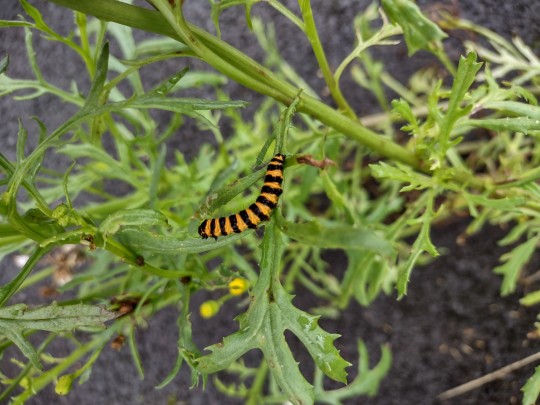
@snowbits submitted: I found this fun colored friend on a yellow flower plant near birmingham in the UK, could you tell me what kind of grub he is?
Suuure it's a cinnabar moth caterpillar :)
97 notes
·
View notes
Text

Daniel Dewar & Grégory Gicquel, Embroidered quilt with earthworms, cockchafer beetle larvae, false barley grass, red fescue grass, poppy plants, meadow fescue grass, English ryegrass, cinnabar moth caterpillar, giant peacock moth caterpillar, hebe tiger moth, death’s-head hawkmoth caterpillar, magpie moth, giant peacock moth, death’s-head hawkmoth, cinnabar moth, sparrow and recorder, 2024, Cotton and polyester thread on linen fabric, cotton batting, 166.5 x 210 cm
54 notes
·
View notes
Photo

Silk in Antiquity
Silk is a fabric first produced in Neolithic China from the filaments of the cocoon of the silk worm. It became a staple source of income for small farmers and, as weaving techniques improved, the reputation of Chinese silk spread so that it became highly desired across the empires of the ancient world. As China's most important export for much of its history, the material gave its name to the great trading network the Silk Road, which connected East Asia to Europe, India, and Africa. Not only used to make fine clothes, silk was used for fans, wall hangings, banners, and as a popular alternative to paper for writers and artists.
Origins & Cultivation
Silk is produced by silk worms (Bombyx mori) to form the cocoon within which the larvae develop. A single specimen is capable of producing a 0.025 mm thick thread over 900 metres (3,000 ft) long. Several such filaments are then twisted together to make a thread thick enough to be used to weave material. Fabrics were created using looms, and treadle-operated versions appear in, for example, the murals in tombs of the Han dynasty (206 BCE - 220 CE). The silk could be dyed and painted using such minerals and natural materials as cinnabar, red ochre, powdered silver, powdered clam shells, and indigo and other inks extracted from vegetable matter.
Sericulture - that is the cultivation of mulberry leaves, the tending of silkworms, the gathering of threads from their cocoons and the weaving of silk - first appears in the archaeological record of ancient China c. 3600 BCE. Excavations at Hemudu in Zhejiang province have revealed Neolithic tools for weaving and silk gauze. The earliest known examples of woven silk date to c. 2700 BCE and come from the site of Qianshanyang, also in Zhejiang. Recent archaeological evidence suggests that the Indus Valley civilization in the north of the Indian subcontinent was also making silk contemporary with the Neolithic Chinese. They used the Antheraea moth to produce silk threads for weaving.
However, silk production on a large scale and involving more sophisticated weaving techniques would only appear from the Chinese Shang and Zhou dynasties in the 2nd millennium BCE. Silk then became one of the most important manufactured and traded goods in ancient China, and finds of Shang dynasty (c. 1600 - 1046 BCE) silk in an Egyptian tomb are testimony to its esteemed value and use in early international trade.
Continue reading...
31 notes
·
View notes
Text
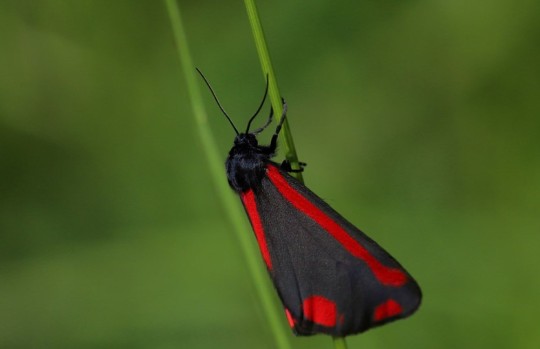
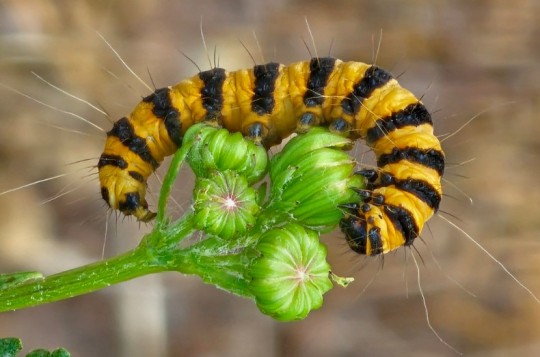
Cinnabar Moth (Tyria jacobaeae)
Family: Underwing Family (Erebidae)
IUCN Conservation Status: Unassessed
Native to northern Asia and Europe, Cinnabar Moths begin their lives as caterpillars feeding almost exclusively on Common Ragwort (a species of plant containing foul-tasting defensive alkaloid chemicals in its tissues that deter most herbivorous insects and are mildly poisonous to many mammals and birds.) In addition to being immune to the effects of the ragwort's chemicals, the caterpillars of this species are able to incorporate them into their own tissues, gradually becoming toxic themselves as they feed in order to ward off most would-be predators; this acquired toxicity, combined with their striking yellow-and-black warning colouration and the rigid hair-like structures (called setae) that line their bodies and allow them to cause itchy rashes on contact by forcing toxins into the tissues of larger animals that touch them, mean that only a small number of highly specialised predators (such as certain species of ants) pose a threat to them, and as such in areas with large populations of Cinnabar Moth caterpillars it is not uncommon for the main cause of death among the larvae to be starvation as they are able to spread between ragwort plants freely and quickly strip an area of food. Developing throughout the summer, individuals that manage to reach a suitable size and age to undergo metamorphosis burrow underground where they spend the winter as pupae, emerging in the following spring as winged, nectar-drinking adults and breeding throughout the spring and summer, with females laying their eggs on the underside of ragwort leaves. Unlike most moths adult Cinnabar Moths are active during the day, and though less toxic than they once were they retain enough toxins from their larval stage to give them an unpleasant bitter taste, with the beautiful red markings on their otherwise jet-black bodies warning would-be predators of this.
--------------------------------------------------------------------------
Image Source: https://www.inaturalist.org/taxa/51781-Tyria-jacobaeae
#Cinnabar moth#moth#moths#zoology#biology#animal#animals#insect#insects#wildlife#Asian wildlife#European Wildlife#Lepidopterology#entomology
41 notes
·
View notes
Text
Moth of the Week
Cinnabar Moth
Tyria jacobaeae

The cinnabar moth is part of the Erebidae family, one of the largest moth families. It is named after the mineral cinnabar, which is a similar bright red to the moth’s red & black wings. This species was first described in 1758 by Carl Linnaeus and can be seen flying during the day and night.
Description Cinnabar moths usually have black forewings with red patterns and red hindwings with a black border. However on rare occasions, the red is replaced with yellow, or the forewings are red with a black border or fully black. These colors tell potential predators that the cinnabar moth is unpalatable, or has a unpleasant bitter taste.
Average wingspan of 37 mm (≈1.5 in)
Diet and Habitat These moths are native to Europe, eastern and central Asia, Siberia, and China. This species feeds on plants in the Senecio genus, especially ragwort. This plant is the reason why cinnabar moths do not taste good to predators since the caterpillars absorb bitter substances from the ragwort’s leaves. This plant is also why the cinnabar moth was brought to New Zealand, Australia, and North America since ragwort is an invasive plant species.
Mating Mating season for cinnabar moths is in early August. Female moths can lay up to 300 eggs on the underside of ragwort leaves in batches of 30 to 60 eggs.
Predators Most predators avoid cinnabar moths and larvae, except for various species of the cuckoo bird. Cinnabar moths have few predators because are a bright red, signaling to predators that they are unpalatable, or have a unpleasant bitter taste.
Fun Fact (CW: cannibalism) If and when the cinnabar caterpillars run out of leaves to eat on the ragwort plant, they will turn to cannibalism and eat each other for survival.
(Source: Wikipedia, Buglife)
#animals#bugs#facts#insects#libraryofmoths#mothoftheweek#moth#cinnabar moth#Lepidoptera#Erebidae#Tyria jacobaeae#TW: cannibalism#CW: cannibalism
53 notes
·
View notes
Text
Wings of Fire Dragin Guide, Part Five: HiveWings and SilkWings

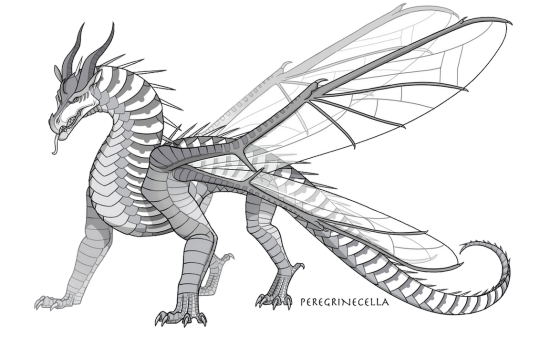

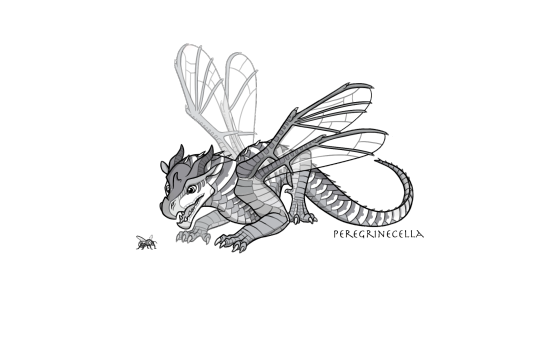
This is a HiveWing, or hive dragon. They have red, orange, and/or yellow scales, but always have some black scales on them as well. They are distantly related to SilkWings. Their powers can range from wrist/tail/claw stingers, the ability to shoot some stingers and regrow them, venomous fangs, paralyzing toxins/boiling acid/pain-inducing venom and possibly more unexplored options. They have four dragonfly/wasp-like wings, and live in the Hives across the savanna (now partially forest) continent of Pantala. Their diet consists of zebra, gazelle, birds, snakes, sharks, fish, as well as apples,, cinnamon, honey, nectar, confectionery, and coffee and tea.. They are named after different insects except for moths and butterflies, such as:
Social insects (Hymneoptera): Wasp, Hornet, Yellowjacket...
Beetles (Coleoptera): Scarab, Weevil, Chafer, Bombardier...
Orthoptera: Cricket, Grasshopper, Katydid...
Auchenorryhncha: Cicada, Treehopper...
Larvae/Worms: Rootworm, Glowworm, Inchworm...
Arachnid: Vinegaroon...
Other insects: Mantis, Earwig, Aphid, Dragonfly...

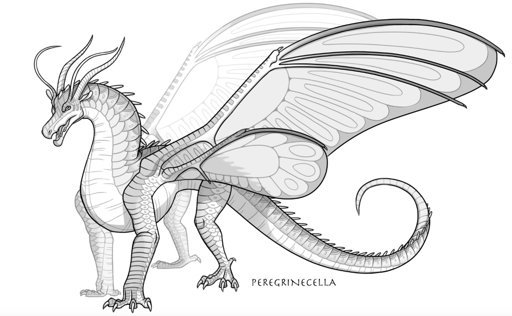


This a SilkWing, or silk dragon, or butterfly dragon. They can be any color and shade except black, are distantly related to HiveWings, and are iridescent. They hatch with wingbuds, as they will go through Metamorphosis, where they spin a Chrysalis and form their wings like a butterfly or moth, at age six. They also inherit their silk glands and silk spinning abilities after this, but can sometimes have flamesilk, which can glow, burn, and be made of fire, but it is extremely rare. They are vegetarian, so they eat things such as tangerines, kumquats, persimmons, garbanzo beans, kale, AZ well as honey, nectar, and confectionery made in the Hives. They were once second-class citizens, until Queen Wasp was defeated and everyone was free from the Othermind (a hivemind-esque thing made up of one small evil plant, an insane *sshole of a human who is the reason the humans were almost wiped out by the dragons, and one of the dragon eggs he stole, which is the dragonet from the egg). (Yes, the Scorching, which is their event that formed the dragon tribe and world as we know it, is because this freaky little jerk of a man stole dragon eggs, thus causing other human kingdoms to do so. So the dragon parents banded together and literally scorched the world to the the ground. Then they chose the first dragon queen, and the tribes formed over the next few hundred years after...) SilkWings are named after butterflies and moths, such as:
Butterflies: Monarch, Blue, Swordtail, Fritillary, Tortoiseshell, Admiral, Heliconian, Argus...
Moths: Luna, Io, Tussock, Cinnabar, Orange, Festoon, Lappet, Burnet...
#honeycomb thoughts#platonic yandere marvel#yandere platonic marvel#platonic yandere xmen#🐉wings of fire au#🥚tiny talons🐉 au#🥚tiny heir❄ au#🥚tiny sting🐝 au#🍷the heir of evil🐉 au#🍯honey and venom🧪 au
7 notes
·
View notes
Note
I just realized I never quite explained why I picked Cinnabar as the final name, did I?
At first, it was just because of the neat coloration of the moth, looking like something you would typically see on a villian and applying that to a hero sounded interesting, but then I found another interesting fact later on.
The larva and catapillers that become Cinnabar moths eat ragwort, a toxic weed that can even kill horses and cows if they end up eating it.
So, it's a funny case of accidental symbolism as part of story is how just by being there, Cinnabar is helping Queen Bee become a better person.
Breaking bad habits, helping to understand social situations, eating away at the darkness surrounding her heart to let the light shine though.
And in return, Queen Bee helps Cinnabar exist and break free of the misery and pain of the loss of his wife, and to reconnect with his son after he almost followed in his fathers footsteps.
So yeah, TLDR; the name Cinnabar was picked cause of colors, stuck because of accidental symbolism.
Honestly I love coincidental symbolism!
10 notes
·
View notes
Note
well in that case, here's a small variety of moth recommendations!
Cinnabar moths
Crimson speckled moths
Elephant Hawk-moths
and Green carpet moths
-moth anon
[ooc: i have a whole list of neat moths to pick from so if its okay i would love to randomly invade the inbox with cool moths and possibly other bugs if im feeling silly :3]
These are all absolutely gorgeous! Perhaps I could acquire some eggs or larvae, my friends would be quite pleased with so many new additions.
Here are some pictures of each, in case anybody else is interested in enlarging their own swarm, or simply has an interest in moths.
Cinnabar moth (Tyria jacobaeae)


I cannot tell why but this one reminds me of Jonathan– The colouring, perhaps.
Crimson speckled moth (Utetheisa pulchella)


Curiously enough, this one reminds me of Jonah. I hope I won't end up associating moths to each of my friends.
Elephant hawk-moth (Deilephila elpenor)


Of course I would immediately grow fond of this one– It is pink!
Green carpet moth (Colostygia pectinataria)


Beautiful, lovely, and they do a wonderful job of blending into leafy backgrounds. Perhaps it would be nice to surprise someone who is afraid of moths with these.
Thank you for sharing these with me! I look forward to getting acquainted with them myself if I can manage it.
3 notes
·
View notes
Note
Favorite insect????????????? :0
OHHHHHHHH NOW THIS IS A GOOD QUESTION
Cinnabar moths are my favourite moths bc 1) they're named after the mineral and 2) the caterpillars are incredibly good lads who eat ragwort, which is super invasive in a whole lot of countries. Cinnabar moths can be introduced into these countries and have little effect on the ecosystem other than fucking up that ragwort!
Cape stag beetles are my favourite beetles bc they are REMNANTS OF AN ANCIENT ECOSYSTEM. Through chromosomal analysis, they've found that all the different species diverged during the Miocene era, which is marked by an increase in tebperature and aridity in the Cape Fold Belt in South Africa. These beetles lived in the valleys when they were foggy and humid and when this started to change, they managed to climb up into the mountains where it was still cool and wet enough for them. As the climate started to stabilise, they all began to adapt to the specific mountain top they were confined to, and that's why there are specific species now. There's something so COOL about them being the last part of that ecosystem and thriving despite it changing!!!
I'm currently reading a paper about Trilobite beetles though, and they are INCREDIBLY cool as well. The females stay in their larvae form instead of becoming beetles and they look SO SICK, literally like little trilobites!!!
#ask#oh ny god i love insects#i am exploding from joy reading this research paper oh my god#them staying in larvae form has implications for macro evolution and just AHHHH#SO COOL#my next thing to look up is carnivorous bees#bc WHAT THE FUCK THATS FASCINATING#also im sorry if it took me a bit to answer! im bad at checking messages
2 notes
·
View notes
Text
attention ‼️
cinnabar moth larvae :)
1 note
·
View note
Text
Double Jeopardy. The poisonous larvae of the Cinnabar Moth on the poisonous foliage of Ragwort. Lots of each to be found on the hill right now. 19th July 2024
0 notes
Text
Cinnabar moth

The cinnabar moth (Tyria jacobaeae) is a brightly coloured arctiid moth found as a native species in Europe and western and central Asia then east across the Palearctic to Siberia to China. It has been introduced into New Zealand, Australia and North America to control ragwort, on which its larvae feed. The moth is named after the red mineral cinnabar because of the red patches on its predominantly black wings. The species was first described by Carl Linnaeus in his 1758 10th edition of Systema Naturae. Cinnabar moths are about 20 mm (0.79 in) long and have a wingspan of 32–42 mm (1.3–1.7 in).


Dykebeck, 17 June 2023
0 notes
Photo





Invertebrates Amwell Nature Reserve
0 notes
Text


FINALLY seeing some cinnabar moth cats on the ragwort. It's been the worst year for them in ages here. Although we've seen adults emerging from May onwards, there have been way fewer caterpillars than usual. Idk if that relates to the heatwave or other factors.
#moth#lepidoptera#insect#nature#moths#team moth#teammoth#insects#insecta#caterpillar#caterpillars#larva#larvae#cinnabar#cinnabar moth#cool bugs#cute bugs
21 notes
·
View notes
Text
@fluffydogsquad submitted: Caterpillar party I saw on a sand dune in Ireland (forgot the exact location as this was a few years ago). I love the little reach the top one is doing. Any idea what kind they are?

Dang that's a BIG caterpillar party. Hope they were having a grand ol' time. They're cinnabar moth caterpillars! :)
187 notes
·
View notes
Photo

Blodplet (Tyria jacobaeae)
Larve på foderplanten engbrandbæger (Jacobaea vulgaris).
Cinnabar moth (Tyria jacobaeae)
Larva on the food plant Common Ragwort (Jacobaea vulgaris).
#Blodplet#Tyria jacobaeae#Tyria#Cinnabar moth#Cinnabar#Moth#Sværmer#Sommerfugl#Butterfly#Lepidoptera#engbrandbæger#Jacobaea vulgaris#Jacobaea#Brandbæger#Common ragwort#Ragwort#Sdr. Resen Naturpark#Larve#Larva#Plante#Plant#Poisonous plant#Giftig plante#Gul og sort#Yellow and black#Stribet#Striped
2 notes
·
View notes